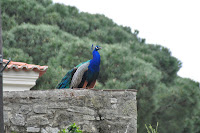Cascais is very lovely indeed, but if you cannot swim or lie on the beach, there is not incredibly much to see. At this time of the year is still quite cold. It wasn't necessarily bad since we wanted to go to Cabo da Roca. From Cascais one can drive to Sintra, where we've already spent a few days before, or go with the bus number 403 for around 20 minutes to Cabo da Roca. The bus station is located at the big shopping mall next to the train station.
Cabo da Roca is not only the westernmost point of continental Europe but also an impressive and dramatic landscape with mountains, steep cliffs and the crashing waves of the Atlantic Ocean. We walked around the area watching the ever-changing weather and the magnificent scenery. We were not alone as there were many chartered buses arrived with loads of tourists. A pretty mixed crowd. One bus was full of young people probably on their school excursion, and the other was with elderly people. Nevertheless, it was a very quiet around. There was nothing more for us to do there, so we took the bus back to Cascais.
It was still early, so we decided to go back to Lisbon and see more of the sights. We were only at the Tower of Belém and Oceanario, and we didn't have much time then. This time we walked from "Cais do Sodre" station along the river bank into a vast square, the Praça do Comercio. From there we went to the unique Casa dos Bicos. This 16th-century architectural curiosity belongs to Afonso de Albuquerque, the Portuguese viceroy of India, and one of the few buildings that survived the 1755 earthquake. Then we went uphill to the Sé de Lisboa, the cathedral, where amongst other things to see were a few Pope's Mitre. We planned to continue the same upward way to the Castelo de São Jorge but somehow gone astray, but this was not bad because we ended up on an observation deck. Unfortunately, there was a somewhat annoying and persistent beggar who comes running to whoever approached the platform. I'm sorry, but I just can't solve the world's problem.
Cabo da Roca is not only the westernmost point of continental Europe but also an impressive and dramatic landscape with mountains, steep cliffs and the crashing waves of the Atlantic Ocean. We walked around the area watching the ever-changing weather and the magnificent scenery. We were not alone as there were many chartered buses arrived with loads of tourists. A pretty mixed crowd. One bus was full of young people probably on their school excursion, and the other was with elderly people. Nevertheless, it was a very quiet around. There was nothing more for us to do there, so we took the bus back to Cascais.
"Cabo da Roca was known to the Romans as Promontorium Magnum and during the Age of Sail as the Rock of Lisbon."
It was still early, so we decided to go back to Lisbon and see more of the sights. We were only at the Tower of Belém and Oceanario, and we didn't have much time then. This time we walked from "Cais do Sodre" station along the river bank into a vast square, the Praça do Comercio. From there we went to the unique Casa dos Bicos. This 16th-century architectural curiosity belongs to Afonso de Albuquerque, the Portuguese viceroy of India, and one of the few buildings that survived the 1755 earthquake. Then we went uphill to the Sé de Lisboa, the cathedral, where amongst other things to see were a few Pope's Mitre. We planned to continue the same upward way to the Castelo de São Jorge but somehow gone astray, but this was not bad because we ended up on an observation deck. Unfortunately, there was a somewhat annoying and persistent beggar who comes running to whoever approached the platform. I'm sorry, but I just can't solve the world's problem.
We went ahead and found the way to the Castelo. Along the way, I found an unusual public pissoir installation. Once on top, we got our ticket and did our tour. You can see the view of Lisbon from all direction, and one was basically perched on top of the city. The castle of St George is a Moorish castle and a strongly fortified citadel which dates back to the middle ages. The historic site was very extensive. We went to an excavation area where it used to be the centre of the citadel. There were also some peacocks roaming around which was a welcome change. After the tour of the fortress, we went back down as we wanted to ride the historic tram of Lisbon. We were not the only ones with this idea. The train was full, and I was standing next to a drunken man who was also talking loudly (in Portuguese). There was no way I could understand him, which I didn't mind, but the only free seat was next to him. No one seems to want to be seated next to him. My friend was standing and holding on to his wallet because there were warning signs about pickpockets. After a few stops, we were glad to finally be out of the crowded tram.
The time was short, and my two Portuguese friends whom I wanted to meet in Lisbon were either busy, or we were just running from place to place. We then walked back to the suburban train station to go back to Cascais. After a brief visit to the mall in Cascais, we went back to our hotel and just rest and enjoy the place.


















































No comments:
Post a Comment